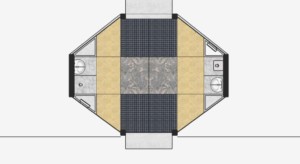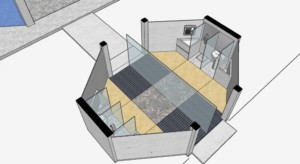PRAIRIE VIEW, Texas (April 1, 2021) – As people adjust to life with the ongoing threat of COVID-19 and the newly lifted mask mandate in Texas, designers and architects are rethinking public spaces and how to help people maintain the Centers for Disease Control and Prevention’s guidelines for safe social distancing. This includes researchers at Prairie View A&M University (PVAMU) who are exploring new ways to keep people free from the disease.
Assistant Professor of Practice Tareef Hayat Khan, Ph.D., from PVAMU’s School of Architecture (SOA), recently presented results of his study and a number of pandemic-responsive design concepts at an international online event hosted by Universiti Teknologi Malaysia (UTM). UTM is ranked in the top 50 universities in Asia. The presentation allowed Khan to address a pressing need in the region.
“In the Asian context, public open spaces are sometimes even more crowded than in other parts of the world. The audience found the ideas really exciting, especially as the pandemic is a current issue, and not much has been addressed on the design of the landscape in urban open spaces [in the past],” Khan said.
Students from around the world, including Malaysia, Indonesia, India, Singapore, and Thailand, joined the video conference. Khan said that providing well-researched design ideas that can be used in real-world applications immediately was essential, particularly for students working in Asia, where it can be difficult to maintain social distancing and COVID-19 infection is widespread.
“The architects, as everyone in all other professions, need to address this pandemic in every aspect. This research covers only a small part of what architects can contribute to responding to the pandemic,” he said.
The first part of Khan’s study investigated safer pedestrian movement methods in public open spaces in the wake of the pandemic and suggested possible adaptations in the landscape design to make it easy for users to maintain the CDC guidelines for COVID-19.
Once Khan established these safer pathways, the second part of his research examined better solutions for sanitizing public buildings. This included the use of temporary, portable sanitation pods. These pods address four basic sanitization activities: a hand sanitizing station, a washing station, a mask dispenser, and a trash can.


Figure: A hypothetical example of a sanitizing pod with a specific geometry
The lessons from the first part of the study, including observing how people travel through public spaces, were used to identify the most strategic locations for sanitization pods or where they would be the most valuable and effective. Using this research, Khan was able to map out geometric zones with optimal pathways and sanitization areas.
“It may appear to be a trivial issue … to renovate the landscape of a public open space, only because [people] might be thinking that the pandemic will not last forever. [But] the concern for such pandemic-responsive landscape design can only improve us as better serving professionals and better serving humans,” Khan said.
Architecture and design are at the forefront of COVID-19 adaptation as the world transitions back to public life. Both interior and exterior design can have a significant effect on preventing transmission during pandemics, both now and in the future.
By Jocelyn Kerr
-PVAMU-

